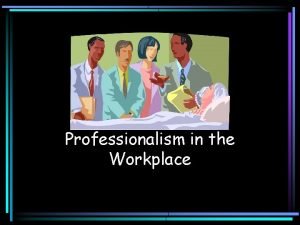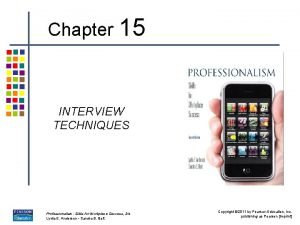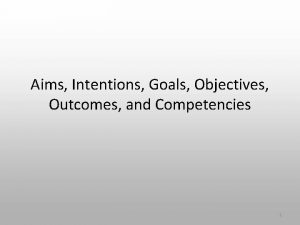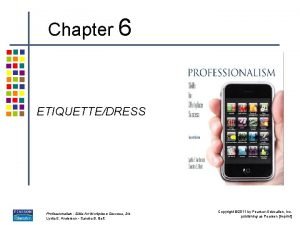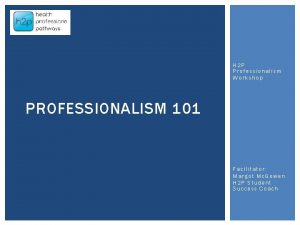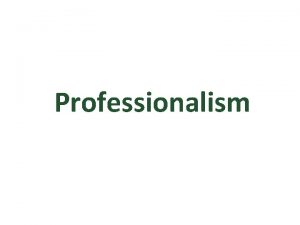Communication Professionalism What is communication Communication is the














- Slides: 14

Communication & Professionalism

What is communication? � Communication is the way in which we share thoughts, ideas, and information.

Why is professional communication important? � Communication is key in daily interactions. When you are in a professional environment, it is instrumental for you to communicate effectively and professionally. � Professional communication can make the difference between a positive work experience and a negative one.

How can you communicate professionally? � In order to communicate effectively, you must first be aware of how you communicate. �To do this, take a communication style survey or ask others that you have worked closely with for some feedback on what they have noticed in their interactions with you. � After assessing how you communicate, attempt to discover how your co-workers or others in your professional setting communicate. �You may find that they are unaware of their own communication styles so be sure to not only ask them how they prefer to communicate but others that they have worked with as well.

Keys to Professional Communication � Consider your communication style � Consider your target audience � Outline your main purpose for communicating � Determine which form of communication is appropriate � Make a draft of what exactly you wish to communicate � After you have communicated, follow-up to ensure that your message came across correctly

Verbal Communication � The act of expressing your thoughts aloud with words. � Components ◦ ◦ ◦ � Tone Enunciation Pauses Loudness Emphasis Word choice Examples: ◦ ◦ Group meeting 1: 1 meeting Speech/Presentation Phone conversations

Nonverbal Communication � Nonverbal communication coincides with verbal communication and oftentimes is more influential than what you are saying with words. � Examples: ◦ ◦ ◦ Facial expressions Gestures Body movements and posture Eye contact Touch

Keys to Professional Verbal & Nonverbal Communication Verbal � � Nonverbal Remain authentic � Be actively engaged in the conversation � � � Be respectful in your tone � Do not interrupt Rephrase or ask for clarification � Maintain eye contact (but always be aware of cultural norms) Avoid crossing your arms Be aware of your facial expressions Try to lean into the conversation rather than away from it Be aware of any gestures you are using and how they are adding to or hindering your message

Scenarios: Professional Verbal & Nonverbal Communication Formal � � How do you professionally communicate when you are at a board meeting where your CEO and supervisor are present? What verbal and nonverbal communication should you be using? Informal � � How do you professionally communicate with a good friend that is also a coworker when you are working together on a project? What verbal and nonverbal communication should you be using?

Written Communication � Strive to be pithy: simple and to the point � Like any skill, good writing requires practice, feedback, and ongoing improvement. � Consider your main message & your target audience. � Examples: ◦ ◦ E-mail Notes/Memos Text message Social networking (i. e. Facebook, Twitter)

Keys to Professional Written Communication � Outline your main purpose for communicating � Consider your target audience � Determine which form of written communication is appropriate � Proof read, proof read!

Scenarios: Professional Written Communication Formal � � You are communicating with your supervisor about a project you are working on. You are reaching out to potential community partners and are expected to foster a positive, transformative relationship. Informal � � You are communicating with a co-worker about a project you are working on. You are communicating with a community partner that you have an established personal and professional relationship with.

Professional Communication Recap � Be aware of how you communicate � Consider audience your main message and your target � Determine which form of communication is appropriate � Ask for feedback and assess if any changes need to be made

Communication & Professionalism
 Professionalism examples
Professionalism examples Sales professionalism
Sales professionalism Professionalism
Professionalism Professionalism is judged against a set of
Professionalism is judged against a set of The principles of professionalism
The principles of professionalism Professionalism conclusion
Professionalism conclusion Professionalism skills for workplace success
Professionalism skills for workplace success Professionalism in a sentence
Professionalism in a sentence What are the three p's of professionalism
What are the three p's of professionalism Pillars of professionalism
Pillars of professionalism What is professionalism
What is professionalism Professionalism skills for workplace success
Professionalism skills for workplace success Professionalism in computing
Professionalism in computing Professionalism workshop
Professionalism workshop Vanderbilt professionalism program
Vanderbilt professionalism program



